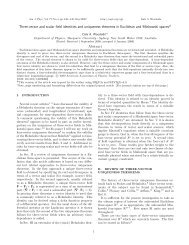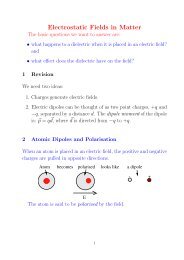Chapter 8 Vector Spaces in Quantum Mechanics
Chapter 8 Vector Spaces in Quantum Mechanics
Chapter 8 Vector Spaces in Quantum Mechanics
You also want an ePaper? Increase the reach of your titles
YUMPU automatically turns print PDFs into web optimized ePapers that Google loves.
<strong>Chapter</strong> 8 <strong>Vector</strong> <strong>Spaces</strong> <strong>in</strong> <strong>Quantum</strong> <strong>Mechanics</strong> 92as was done <strong>in</strong> the case of the two slit, or sp<strong>in</strong> half systems. Thus, <strong>in</strong> the two slit example,the two possible <strong>in</strong>termediate states are those for which the particle is to be found at theposition of either of the two slits. In the sp<strong>in</strong> half example, the two <strong>in</strong>termediate states arethose <strong>in</strong> which the sp<strong>in</strong> is observed to have either of the two values S z = ± 1 ; these are2the states we have been call<strong>in</strong>g |±〉. These <strong>in</strong>termediate states are states of the system thatcan be identified through an argument based on the idea that some physical property ofthe system can be exhaustively measured to yield a set of values that we then use to labela complete set of basis states for the state space of the system.Negatively Charged Ions Here the system is a molecule which has acquired an extraelectron, which can be assumed to found only on any one of the atoms mak<strong>in</strong>g up themolecule. This is, of course, an approximation. The electron could be found anywherearound the atoms, or <strong>in</strong> the space between the atoms, <strong>in</strong> a way that depends on the natureof the chemical bond between the atoms. Here we are mak<strong>in</strong>g use of a coarse notion ofposition, i.e. we are assum<strong>in</strong>g that the electron can be observed to reside on one atom orthe other, and we do not really care about exactly where on each atom the electron mightbe found. The idea is best illustrated by the simple example of the O − 2ion <strong>in</strong> which theelectron can be found on one or the other of the oxygen atoms (see Fig. (8.3)). If we letx = ±a be the positions of the two atomic nuclei with respect to a po<strong>in</strong>t midway betweenthem, then we can use these two possible positions of the electron to label the possiblestates of the system. The two states are then | − a〉 and | + a〉. If the electron is observedto be on the oxygen atom at x = +a, then it has unit probability of be<strong>in</strong>g observed on theatom at x = +a, but zero probability of be<strong>in</strong>g observed on the atom at x = −a. Thesetwo states represent mutually exclusive possibilities, and so they are dist<strong>in</strong>ct orthonormalstates:〈+a| + a〉 = 〈−a| − a〉 = 1〈+a| − a〉 = 〈−a| + a〉 = 0 (8.58)These two states are also complete <strong>in</strong> that, with<strong>in</strong> the limits of our model, there is nowhereelse for the electron to be found – it is either on the atom at x = +a or on the atom atx = −a. These two states form a complete set of orthonormal basis states for the statespace of the ion, so that any state of the ion can be expressed <strong>in</strong> the form|ψ〉 = c 1 | + a〉 + c 2 | − a〉 (8.59)where c 1 , c 2 are complex numbers – this is just the completeness relation for this system.Likewise, any l<strong>in</strong>ear comb<strong>in</strong>ation of {| + a〉, | − a〉} will represent a possible state of theion. As there are two basis states, the state space for the system has dimension 2.This k<strong>in</strong>d of model can be generalized to situations <strong>in</strong>volv<strong>in</strong>g different geometries, suchas atoms arranged <strong>in</strong> a r<strong>in</strong>g e.g. an ozone ion O − 3. In this case, the state space will bespanned by three basis states correspond<strong>in</strong>g to the three possible positions at which theelectron can be observed. This model (and its generalizations to an arbitrary number ofatoms arranged <strong>in</strong> a r<strong>in</strong>g) is valuable as it gives rise to results that serve as an approximatetreatment of angular momentum <strong>in</strong> quantum mechanics.
















